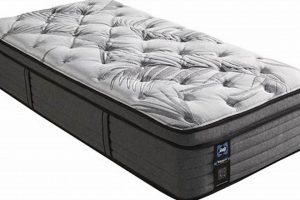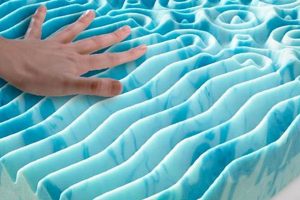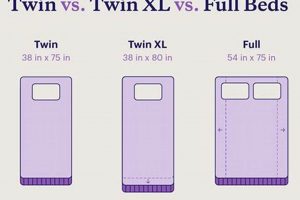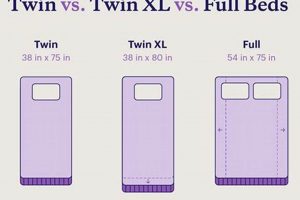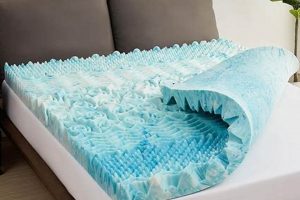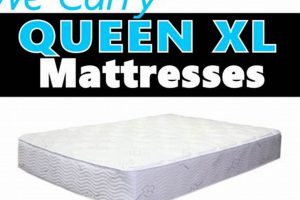A sleeping surface of this description combines specific attributes. “Twin XL” denotes standardized dimensions, typically 38 inches wide and 80 inches long, offering extra length compared to a standard twin. The “firm” descriptor indicates a minimal degree of give or compression when pressure is applied. This construction generally provides enhanced support and limits sinking, which can be beneficial for spinal alignment. As an example, this type of sleep product might be selected for use in college dormitories or guest rooms where space is a consideration but comfort and support remain important.
The importance of selecting an appropriate sleeping surface extends to overall well-being. Increased support can be advantageous for individuals with back pain or those who prefer a feeling of sleeping “on top” of the mattress rather than “in” it. Historically, firmer options were frequently recommended by medical professionals for posture and spinal health; however, modern recommendations also emphasize individual comfort preferences. The elongated dimensions cater to taller individuals, preventing the discomfort of feet hanging off the edge of the bed. This increased length and firm support level offer a balance of space efficiency and potential health advantages.
Subsequent sections will delve into detailed aspects, including material composition, suitability for different sleep positions, comparisons with other types of mattresses, factors affecting pricing, and consumer considerations when selecting an appropriate option. The analysis will also explore maintenance requirements and longevity aspects pertinent to this category of sleeping surface.
Essential Considerations for Optimal Use
The following recommendations are designed to maximize the lifespan and ensure appropriate utilization of a specific bedding choice. Adherence to these guidelines can contribute to enhanced comfort and sustained support characteristics.
Tip 1: Select an Appropriate Bed Frame: Verify the bed frame provides adequate support across the entire surface. Slatted frames should have closely spaced slats to prevent sagging. Center support is especially crucial for ensuring even weight distribution and preserving the integrity of the structure.
Tip 2: Utilize a Mattress Protector: A waterproof, breathable mattress protector is essential. It shields against spills, stains, and allergens, thereby extending the lifespan and preventing potential warranty voids caused by soiling.
Tip 3: Rotate Regularly: Rotate the mattress 180 degrees every three to six months. This promotes even wear and prevents body impressions from forming in specific areas, thus maintaining consistent firmness across the surface.
Tip 4: Maintain Proper Ventilation: Ensure sufficient airflow around the mattress. Avoid placing it directly on the floor without a supporting frame, as this can trap moisture and promote mold or mildew growth. Regular airing out is recommended.
Tip 5: Adhere to Weight Restrictions: Exceeding the specified weight limit can compromise the internal structure and reduce support. Consult the manufacturer’s guidelines to ascertain the maximum weight capacity.
Tip 6: Implement Correct Cleaning Procedures: Spot clean spills immediately with a mild detergent and water. Avoid using harsh chemicals or excessive moisture. Professional cleaning may be required for persistent stains.
Tip 7: Assess Support Needs: A topper can be added if additional cushioning is desired. Consider the impact of increased softness on spinal alignment before making adjustments.
Following these guidelines promotes enhanced sleeping quality, sustained product longevity, and appropriate support levels.
The next section will focus on common issues, potential solutions, and frequently asked questions concerning this type of bedding product.
1. Support and Alignment
The relationship between support, spinal alignment, and a specific bedding configuration is pivotal in promoting restorative sleep. The inherent characteristics of the sleeping surface, particularly its firmness and dimensions, directly influence the biomechanical positioning of the sleeper and consequently, musculoskeletal health.
- Surface Firmness and Spinal Curvature
The firmness level dictates the extent to which the sleeper sinks into the mattress. A firmer surface resists excessive compression, maintaining the natural curvature of the spine in both supine and lateral positions. Insufficient support can lead to spinal misalignment, potentially exacerbating existing back pain or contributing to new discomfort. For example, a surface that is too soft might cause the hips to sink excessively when lying supine, flattening the lumbar curve.
- Edge Support and Postural Stability
The integrity of the edges is crucial, especially on smaller mattresses, as individuals often sleep near the periphery. Inadequate edge support can result in a feeling of roll-off and compromise spinal alignment if the sleeper is positioned close to the edge. Solid edge reinforcement prevents sagging and ensures consistent support across the entire sleeping surface, maintaining proper posture regardless of position.
- Weight Distribution and Pressure Relief
The ability to distribute weight evenly is essential for pressure relief and preventing the formation of pressure points, particularly in the shoulders and hips. While “firm” denotes less give, the surface should still conform to the body’s contours to some degree. Uneven weight distribution can lead to localized pressure build-up, potentially causing discomfort, restlessness, and disrupted sleep. The extended length accommodates a broad range of body types, contributing to more equitable weight distribution.
- Sleeping Position and Support Requirements
Optimal spinal alignment necessitates adapting the level of support to the dominant sleep position. Side sleepers generally require a degree of contouring to accommodate the shoulders and hips, while back sleepers benefit from consistent support across the lumbar region. While a surface with a “firm” designation prioritizes support, selecting the appropriate thickness and materials that complement one’s primary sleep posture is critical to maintaining proper alignment.
These facets illustrate how a specific mattress configuration directly contributes to spinal alignment and overall sleep quality. The dimensions and firmness level provide a foundation for support, while individual preferences and sleeping positions dictate the need for supplementary features, such as toppers or specialized materials. Understanding these nuances is essential for selecting a mattress that effectively promotes both comfort and postural health.
2. Durability and Longevity
The interconnectedness of durability and longevity is a key element in assessing the long-term value of a firm twin XL mattress. Durability, defined as the ability to withstand wear, pressure, or damage, directly affects the lifespan of the product. A mattress with robust construction and high-quality materials will inherently resist sagging, indentation, and structural degradation more effectively than a counterpart constructed with inferior components. For instance, a firm twin XL mattress using high-density foam and reinforced stitching is likely to maintain its shape and support characteristics for a longer duration compared to one utilizing low-density foam and weaker seams.
The longevity of such mattresses has significant practical implications. Mattresses experiencing premature failure can lead to discomfort, sleep disturbances, and ultimately, increased replacement costs. The initial investment in a more durable model may prove more cost-effective over time by reducing the need for frequent replacements. Furthermore, the prolonged use of a well-maintained and durable mattress minimizes potential environmental impact associated with disposal and manufacturing of replacement products. Consideration should be given to factors that can degrade a mattress, such as excessive weight, lack of proper support from the bed frame, or failure to utilize a mattress protector against spills and allergens. These external factors influence the lifespan independent of the mattress’ inherent design.
In summary, the durability and longevity of a firm twin XL mattress are paramount to its long-term utility and economic value. A higher initial investment in a product constructed with resilient materials and superior craftsmanship can translate into years of sustained support and comfort, ultimately reducing the overall cost of ownership. Understanding the significance of these attributes enables consumers to make informed decisions that align with their long-term sleep quality and budgetary considerations.
3. Material Composition
The material composition of a firm twin XL mattress directly dictates its performance characteristics, encompassing support, durability, and overall comfort. The selection of specific materials exerts a profound influence on the firmness level, a defining attribute of this type of mattress. High-density foams, such as high-density polyurethane or latex, are often employed to achieve the desired firmness. The inherent density of these materials resists compression, providing a stable and supportive sleeping surface. In contrast, lower-density foams or softer materials, such as memory foam, would result in a less firm feel. The internal architecture, including the presence of innersprings, also contributes significantly. A mattress incorporating a tightly coiled innerspring system, particularly one with a high coil count, will generally exhibit greater firmness than one relying solely on foam construction. The layering of these materials also affects the degree of firmness experienced; a thin comfort layer atop a dense support core will maintain a firmer feel compared to a thick, plush comfort layer.
Examining the impact through examples clarifies the material’s role. A mattress comprised of high-density polyurethane foam with a Bonnell coil innerspring system will exhibit considerable firmness and resilience, suitable for individuals requiring substantial support. A similar mattress constructed with lower-density foam and a pocketed coil system, while potentially offering superior motion isolation, will possess less firmness. Similarly, a latex mattress, known for its natural resilience, tends to be firmer than those composed of synthetic foams. Understanding these nuances is crucial for selecting a mattress that meets specific comfort and support requirements. The practical significance of this understanding lies in enabling consumers to make informed decisions aligned with their individual needs, thereby maximizing sleep quality and minimizing potential discomfort or musculoskeletal issues. For instance, an athlete recovering from an injury may prioritize the firm support provided by a high-density foam mattress to maintain spinal alignment and facilitate healing.
In summary, the material composition is a fundamental determinant of the properties exhibited by a firm twin XL mattress. The selection and arrangement of materials directly influence its firmness, support, durability, and overall suitability for various sleep preferences and physical needs. Challenges remain in accurately assessing material quality and predicting long-term performance based solely on product descriptions. However, understanding the basic principles of material science empowers consumers to navigate the complexities of the mattress market and choose products that effectively promote restful and restorative sleep. Furthermore, by understanding material selection, consumer’s can make informed decisions about the environmental impact of their choices.
4. Cost-Effectiveness
The assessment of cost-effectiveness, when applied to the selection of a firm twin XL mattress, necessitates a comprehensive evaluation extending beyond the initial purchase price. Factors encompassing durability, longevity, and potential health benefits warrant careful consideration to determine the true value proposition.
- Initial Investment vs. Long-Term Value
A lower initial price point may be attractive; however, a mattress with substandard construction or inferior materials may necessitate premature replacement. A marginally more expensive option characterized by robust construction, high-density foams, and reinforced stitching may prove more economical over time due to its extended lifespan. For instance, a mattress priced at $200 that requires replacement every two years incurs a higher long-term cost than a $300 model with a lifespan of five years or more.
- Health and Well-being Implications
The selection of an appropriate sleeping surface directly affects musculoskeletal health and sleep quality. A firm twin XL mattress providing adequate support and promoting proper spinal alignment may mitigate back pain and improve overall well-being, potentially reducing healthcare expenditures associated with sleep-related ailments. Investing in a supportive mattress can thus represent a preventative healthcare measure with quantifiable economic benefits.
- Versatility and Adaptability
The twin XL dimensions render this mattress suitable for a variety of applications, including college dormitories, guest rooms, and smaller living spaces. Its adaptability reduces the need for multiple mattress purchases to accommodate differing spatial requirements. Furthermore, its firm support characteristics may be appropriate for a range of sleep preferences, further enhancing its versatility and cost-effectiveness.
- Maintenance and Upkeep Expenses
While the initial cost constitutes a significant factor, the ongoing expenses associated with maintenance should also be considered. A mattress that is resistant to stains, easy to clean, and compatible with standard mattress protectors minimizes upkeep expenditures. Conversely, a mattress requiring specialized cleaning products or exhibiting susceptibility to damage may incur additional costs over its lifespan.
The confluence of these facets underscores the multifaceted nature of cost-effectiveness in the context of a firm twin XL mattress. A judicious assessment considering initial investment, long-term durability, potential health benefits, adaptability, and maintenance requirements facilitates a more informed purchasing decision that optimizes value and minimizes the overall cost of ownership.
5. Space Optimization
The selection of sleeping arrangements is often dictated by spatial constraints, particularly in environments characterized by limited square footage. The firm twin XL mattress represents a strategic solution for optimizing space while simultaneously accommodating the essential need for comfortable and supportive rest. Its dimensions and construction contribute to efficient space utilization without compromising functionality.
- Dimensional Efficiency
The “twin XL” designation signifies specific measurements typically 38 inches in width and 80 inches in length. These dimensions strike a balance between providing adequate sleeping surface for an individual and minimizing the overall footprint. Compared to a standard twin mattress, the extra length caters to taller individuals without requiring the additional width of a full-size mattress, effectively maximizing floor space in compact rooms. For example, a college dormitory or a small apartment may benefit significantly from this space-conscious design.
- Multi-Purpose Room Utilization
In settings where rooms serve multiple functions, the spatial efficiency of the mattress becomes paramount. The firm twin XL mattress facilitates the transformation of a room from a daytime study or living area to a nighttime sleeping space. Its compact size allows for greater flexibility in furniture arrangement and the incorporation of other essential items, such as desks, storage units, or seating. In shared living spaces, this adaptability minimizes encroachment on communal areas.
- Stackability and Storage
The relatively smaller dimensions of a firm twin XL mattress contribute to its ease of storage when not in use. In scenarios involving temporary accommodations or infrequent overnight guests, the mattress can be readily stored vertically or horizontally, occupying minimal space within a closet or storage unit. This attribute is particularly advantageous in environments where maximizing storage capacity is a priority, such as studio apartments or vacation homes.
- Integration with Bunk or Loft Beds
The firm twin XL mattress is commonly used in conjunction with bunk beds or loft beds, further enhancing space optimization. These configurations capitalize on vertical space, freeing up valuable floor area for other activities. The firmness of the mattress ensures adequate support for sleepers on both the upper and lower bunks, while its dimensions align precisely with standard bunk bed frames. This vertical arrangement maximizes the utility of limited square footage in shared bedrooms or living spaces.
The efficient integration of a firm twin XL mattress within spatially constrained environments underscores its value as a practical and functional sleeping solution. The combination of optimized dimensions, adaptability for multi-purpose use, ease of storage, and compatibility with space-saving bed configurations renders it a compelling choice for individuals seeking to maximize the utility of limited living spaces. Beyond mere spatial considerations, the inherent firmness of the mattress contributes to ergonomic support, ensuring that space optimization does not compromise sleep quality and musculoskeletal health.
Frequently Asked Questions
The following questions address common inquiries and concerns pertaining to a specific type of sleeping surface. Clarity regarding these issues promotes informed decision-making and optimal product utilization.
Question 1: Is this firmness level suitable for individuals with pre-existing back conditions?
While increased support can be beneficial for certain back conditions, suitability varies depending on the specific ailment and individual preferences. Consultation with a medical professional is recommended to determine the appropriate firmness level for optimal spinal alignment and pain management.
Question 2: How does the lifespan compare to other mattress types?
Lifespan depends on factors such as material composition, usage patterns, and maintenance practices. Generally, models constructed with high-density foams and robust innerspring systems exhibit greater longevity than those utilizing less durable materials. Regular rotation and proper support also contribute to extended lifespan.
Question 3: What bed frame types are compatible?
Compatibility extends to various bed frame types, including platform beds, slatted frames, and adjustable bases. Adequate support across the entire surface is essential to prevent sagging and ensure even weight distribution. Slatted frames should feature closely spaced slats and center support.
Question 4: Does the firmness affect temperature regulation?
The relationship between firmness and temperature regulation is indirect. Firmness itself does not inherently affect temperature; however, the materials used to achieve that firmness can influence breathability. High-density foams may restrict airflow, potentially leading to increased heat retention. Conversely, latex or open-cell foams promote greater ventilation.
Question 5: How does this size accommodate couples?
The dimensions are designed for individual occupancy and may prove insufficient for couples seeking comfortable and unrestricted sleep. Couples generally require larger sizes, such as queen or king, to ensure adequate space and minimize sleep disturbances caused by movement.
Question 6: What are the implications for side sleepers?
Side sleepers often require a degree of contouring to accommodate the shoulders and hips and maintain spinal alignment. While this type of mattress provides support, the lack of significant give may lead to pressure points and discomfort for some side sleepers. A topper may be necessary to enhance comfort and alleviate pressure.
In summary, these questions highlight key considerations when evaluating a firm twin XL mattress. Understanding these nuances enables informed decision-making and promotes satisfaction with the selected sleeping surface.
The next section will provide a comparative analysis against other mattress types, underscoring its distinct characteristics and optimal applications.
Firm Twin XL Mattress
This exposition has illuminated various facets of the sleeping surface under discussion. Key attributes, including its support characteristics, dimensional efficiency, and cost implications, have been thoroughly examined. Material composition, durability considerations, and suitability for diverse applications have further clarified its role within the broader landscape of sleep products. The aim has been to provide a comprehensive understanding, enabling informed decision-making based on individual needs and circumstances.
The information presented should serve as a foundation for selecting a sleeping surface that aligns with specific requirements. Continued research and critical evaluation are encouraged, ensuring the chosen product effectively promotes both restful sleep and sustained musculoskeletal health. The ultimate goal remains: optimized sleep hygiene facilitated by informed consumer choices.


